The Contribution of Meteosat Third Generation–Flexible Combined Imager (MTG-FCI) Observations to the Monitoring of Thermal Volcanic Activity: The Mount Etna (Italy) February–March 2025 Eruption
Abstract
1. Introduction
2. Materials and Methods
2.1. The FCI Instrument
2.2. Mt. Etna Eruptive Events of February–March 2025
2.3. Computation of a Normalized Hotspot Index Using MTG-FCI Data
2.4. Analysis of MIR Signal with an Adapted RST-Based Approach
3. Results
3.1. Analysis of Eruption Onset
3.2. Investigating Intensity of Volcanic Thermal Emissions
4. Discussion
5. Conclusions
Author Contributions
Funding
Data Availability Statement
Acknowledgments
Conflicts of Interest
Appendix A
Appendix A.1. MTG FCI L2 CLM Product
| Category | Description | Classification in the Paper |
|---|---|---|
| 0 | Not processed (no/corrupt data) | Missing information |
| 1 | Cloud-free (no snow or ice) | Clear |
| 2 | Cloud-contaminated (partial or semi-transparent cloud) | Clear |
| 3 | Cloud-filled (opaque cloud-filled) | Cloud |
| 4 | Dust-contaminated | Clear |
| 5 | Dust-filled (opaque) | Cloud |
| 6 | Ash-contaminated | Clear |
| 7 | Ash-filled (opaque) | Cloud |
| 8 | Cloud-free (snow- or ice-contaminated) | Clear |
| 9 | Undefined | Missing information |
Appendix A.2. MTG-FCI Analysis of the Crater Area
| Input | Output | ||
|---|---|---|---|
| Satellite longitude [deg] | 0 | ||
| Satellite latitude [deg] | 0 | ||
| Satellite altitude above the Earth’ surface [m] | 35,786,400 | ||
| Height on which the correction will be based (e.g., mount height) [m] | 3000 | ||
| Latitude of the SWIR pixel to be corrected [deg] | 37.775024 | Corrected latitude of the SWIR pixel [deg] | 37.74654 |
| Longitude of the SWIR pixel to be corrected [deg] | 15.002382 | Corrected longitude of the SWIR pixel [deg] | 14.99319 |
| Latitude of the MIR pixel to be corrected [deg] | 37.768257 | Corrected latitude of the MIR pixel [deg] | 37.73978 |
| Longitude of the MIR pixel to be corrected [deg] | 14.994598 | Corrected longitude of the MIR pixel [deg] | 14.98541 |
Appendix A.3. Estimates of FRP from SLSTR SWIR Data
| Symbol | Description, Value and Units |
|---|---|
| FRP | Fire radiative power [MW] |
| P | Constant, depending on the sensor and the channel, 6.1 × 10−9 [W m−2 sr−1 mm−1 K−4] |
| Apix | Pixel area [m2], depending on the satellite zenith view angle |
| s | Stefan–Boltzmann constant, 5.67 × 10−8 [W m−2 K−4] |
| tSWIR | SWIR atmospheric transmittance in the SLSTR S6 spectral channel |
| LSWIR | Spectral radiance of the fire pixel in the SWIR S6 channel [mW m−2 sr−1 nm−1] |
| Lb,SWIR | Mean spectral radiance of the valid background window pixels in the SWIR S6 channel [mW m−2 sr−1 nm−1] |
| Q | Constant, p/180 |
| tSWIR | Atmospheric optical depth in the SWIR S6 channel, value linearly interpolated [76] depending on the total column water vapor (TCWV, in kg/m2) |
| ϑv | Satellite zenith view angle [degree] |
| A, B and C | Values linearly interpolated [76] depending on the total column water vapor (TCWV, in kg/m2) |
References
- Kienle, J.; Shaw, G.E. Augustine Volcano Eruption: Initial Explosive Phase, January 1976: Impact on the Atmosphere; Seismological Report No. 1; Alaskan Earthquake Analysis Center: Anchorage, AK, USA, 1977. [Google Scholar]
- Krueger, A.F. Geostationary satellite observations of the April 1979 Soufriere eruptions. Science 1982, 216, 1108–1109. [Google Scholar] [CrossRef] [PubMed]
- Brazier, S.; Davis, A.N.; Sigurdsson, H.; Sparks, R.S.J. Fall-out and deposition of volcanic ash during the 1979 explosive eruption of the Soufriere of St. Vincent. J. Volcanol. Geotherm. Res. 1982, 14, 335–359. [Google Scholar] [CrossRef]
- Wiesnet, D.; Scott, R.; Matson, M. The NOAA satellites: A largely neglected tool in the land sciences. Adv. Space Res. 1983, 3, 215–222. [Google Scholar] [CrossRef]
- Matson, M. The 1982 El Chichon volcano eruptions—A satellite perspective. J. Volcanol. Geotherm. Res. 1984, 23, 1–10. [Google Scholar] [CrossRef]
- Bizzarri, B.; Pagano, P.; Perrone, M. The use of Meteosat for monitoring volcanic ash plumes in the atmosphere. Riv. Meteorol. Aeronautica 1985, 45, 25–40. (In Italian) [Google Scholar]
- Potts, R.J. Satellite observations of Mt Pinatubo ash clouds. Aust. Meteorol. Mag. 1993, 42, 59–68. [Google Scholar]
- Scarpa, R.; Tilling, R.I.; Sawada, Y. Detection of Explosive Eruptions and Regional Tracking of Volcanic Ash Clouds with Geostationary Meteorological Satellite (GMS). In Monitoring and Mitigation of Volcano Hazards; Springer: Berlin/Heidelberg, Germany, 1996; pp. 299–314. [Google Scholar]
- Glaze, L.S.; Francis, P.W.; Self, S.; Rothery, D.A. The 16 September 1986 eruption of Lascar volcano, north Chile: Satellite investigations. Bull. Volcanol. 1989, 51, 149–160. [Google Scholar] [CrossRef]
- Davies, M.A.; Rose, W.I. GOES imagery fills gaps in Montserrat volcanic cloud observations. Eos Trans. Am. Geophys. Union 1998, 79, 505–507. [Google Scholar] [CrossRef]
- Harris, A.J.L.; Keszthelyi, L.; Flynn, L.P.; Mouginis-Mark, P.J.; Thornber, C.; Kauahikaua, J.; Sherrod, D.; Trusdell, F.; Sawyer, M.W.; Flament, P. Chronology of the episode 54 eruption at Kilauea Volcano, Hawaii, from GOES-9 satellite data. Geophys. Res. Lett. 1997, 24, 3281–3284. [Google Scholar] [CrossRef]
- Harris, A.J.L.; Thornber, C.R. Complex effusive events at Kīlauea as documented by the GOES satellite and remote video cameras. Bull. Volcanol. 1999, 61, 382–395. [Google Scholar] [CrossRef]
- Harris, A.J.L.; Pilger, E.; Flynn, L.P.; Garbeil, H.; Mouginis-Mark, P.J.; Kauahikaua, J.; Thornber, C. Automated, high temporal resolution, thermal analysis of Kilauea volcano, Hawai’i, using GOES satellite data. Int. J. Remote Sens. 2001, 22, 945–967. [Google Scholar] [CrossRef]
- Harris, A.J.L.; Flynn, L.P.; Dean, K.; Pilger, E.; Wooster, M.; Okubo, C.; Mouginis-Mark, P.; Garbeil, H.; Thornber, C.; De La Cruz-Reyna, S.; et al. Real-time satellite monitoring of volcanic hot spots. In Remote Sensing of Active Volcanism; Geophysical Monograph Series; Mouginis-Mark, P.J., Crisp, J.A., Fink, J.H., Eds.; American Geophysical Union: Washington, DC, USA, 2000; Volume 116, pp. 139–159. [Google Scholar]
- Mouginis-Mark, P.J.; Snell, H.; Ellisor, R. GOES satellite and field observations of the 1998 eruption of Volcan Cerro Azul, Galapagos Islands. Bull. Volcanol. 2000, 62, 188–198. [Google Scholar] [CrossRef]
- Wright, R.; De La Cruz-Reyna, S.; Harris, A.; Flynn, L.; Jose Gomez-Palacios, J. Infrared satellite monitoring at Popocatépetl: Explosions, exhalations, and cycles of dome growth. J. Geophys. Res. Solid Earth 2002, 107, ECV-2. [Google Scholar] [CrossRef]
- Harris, A.J.L.; Flynn, L.P.; Matías, O.; Rose, W.I. The thermal stealth flows of Santiaguito dome, Guatemala: Implications for the cooling and emplacement of dacitic block-lava flows. Geol. Soc. Am. Bull. 2002, 114, 533–546. [Google Scholar] [CrossRef]
- Calder, E.S.; Harris, A.J.; Peña, P.; Pilger, E.; Flynn, L.P.; Fuentealba, G.; Moreno, H. Combined thermal and seismic analysis of the Villarrica volcano lava lake, Chile. Rev. Geol. Chile 2004, 31, 259–272. [Google Scholar] [CrossRef]
- Marchese, F.; Malvasi, G.; Ciampa, M.; Filizzola, C.; Pergola, N.; Tramutoli, V. A robust multitemporal satellite technique for volcanic activity monitoring: Possible impacts on volcanic hazard mitigation. In Proceedings of the 2007 International Workshop on the Analysis of Multi-Temporal Remote Sensing Images, Leuven, Belgium, 18–20 July 2007; pp. 1–5. [Google Scholar] [CrossRef]
- Pergola, N.; Marchese, F.; Tramutoli, V.; Filizzola, C.; Ciampa, M. Advanced Satellite Technique for Volcanic Activity Monitoring and Early Warning. Ann. Geophys. 2008, 51, 287–301. [Google Scholar] [CrossRef]
- Marchese, F.; Ciampa, M.; Filizzola, C.; Lacava, T.; Mazzeo, G.; Pergola, N.; Tramutoli, V. On the exportability of robust satellite techniques (RST) for active volcano monitoring. Remote Sens. 2010, 2, 1575–1588. [Google Scholar] [CrossRef]
- Ganci, G.; Vicari, A.; Fortuna, L.; Del Negro, C. The HOTSAT volcano monitoring system based on combined use of SEVIRI and MODIS multispectral data. Ann. Geophys. 2011, 54, 544–550. [Google Scholar]
- Ganci, G.; Harris, A.J.L.; Del Negro, C.; Guehenneux, Y.; Cappello, A.; Labazuy, P.; Calvari, S.; Gouhier, M. A year of lava fountaining at Etna: Volumes from SEVIRI. Geophys. Res. Lett. 2012, 39, L06305. [Google Scholar] [CrossRef]
- Gouhier, M.; Harris, A.; Calvari, S.; Labazuy, P.; Guéhenneux, Y.; Donnadieu, F.; Valade, S. Lava discharge during Etna’s January 2011 fire fountain tracked using MSG-SEVIRI. Bull. Volcanol. 2012, 74, 787–793. [Google Scholar] [CrossRef]
- Cappello, A.; Ganci, G.; Bilotta, G.; Herault, A.; Zago, V.; Del Negro, C. Satellite-driven modeling approach for monitoring lava flow hazards during the 2017 Etna eruption. Ann. Geophys. 2019, 62, VO227. [Google Scholar] [CrossRef]
- Marchese, F.; Filizzola, C.; Lacava, T.; Falconieri, A.; Faruolo, M.; Genzano, N.; Mazzeo, G.; Pietrapertosa, C.; Pergola, N.; Tramutoli, V.; et al. Mt. Etna paroxysms of February–April 2021 monitored and quantified through a multi-platform satellite observing system. Remote Sens. 2021, 13, 3074. [Google Scholar] [CrossRef]
- Alonso, C.; Durão, R.; Gouveia, C.M. A Year of Volcanic Hot-Spot Detection over Mediterranean Europe Using SEVIRI/MSG. Remote Sens. 2023, 15, 5219. [Google Scholar] [CrossRef]
- Di Bella, G.S.; Corradino, C.; Cariello, S.; Torrisi, F.; Del Negro, C. Advancing volcanic activity monitoring: A near-real-time approach with remote sensing data fusion for radiative power estimation. Remote Sens. 2024, 16, 2879. [Google Scholar] [CrossRef]
- Plank, S.; Marchese, F.; Filizzola, C.; Pergola, N.; Neri, M.; Nolde, M.; Martinis, S. The July/August 2019 lava flows at the Sciara del Fuoco, Stromboli–Analysis from multi-sensor infrared satellite imagery. Remote Sens. 2019, 11, 2879. [Google Scholar] [CrossRef]
- Mattia, M.; Di Lieto, B.; Ganci, G.; Bruno, V.; Romano, P.; Ciancitto, F.; De Martino, P.; Gambino, S.; Aloisi, M.; Sciotto, M.; et al. The 2019 eruptive activity at Stromboli volcano: A multidisciplinary approach to reveal hidden features of the “unexpected” 3 July paroxysm. Remote Sens. 2021, 13, 4064. [Google Scholar] [CrossRef]
- Marchese, F.; Filizzola, C.; Mazzeo, G.; Paciello, R.; Pergola, N.; Tramutoli, V. Robust satellite techniques for thermal volcanic activity monitoring, early warning and possible prediction of new eruptive events. In Proceedings of the 2009 IEEE International Geoscience and Remote Sensing Symposium, Cape Town, South Africa, 12–17 July 2009; pp. II-953–II-956. [Google Scholar] [CrossRef]
- Hirn, B.; Di Bartola, C.; Ferrucci, F. Synergetic exploitation of meteorological geostationary payloads «SEVIRI» and «JAMI» for quantitative, real-time, global volcano monitoring. In Proceedings of the 2010 IEEE International Geoscience and Remote Sensing Symposium, Honolulu, HI, USA, 25–30 July 2010; pp. 1549–1552. [Google Scholar]
- Ganci, G.; Cappello, A.; Bilotta, G.; Del Negro, C. How the variety of satellite remote sensing data over volcanoes can assist hazard monitoring efforts: The 2011 eruption of Nabro volcano. Remote Sens. Environ. 2020, 236, 111426. [Google Scholar] [CrossRef]
- Marchese, F.; Falconieri, A.; Pergola, N.; Tramutoli, V. A retrospective analysis of the Shinmoedake (Japan) eruption of 26–27 January 2011 by means of Japanese geostationary satellite data. J. Volcanol. Geotherm. Res. 2014, 269, 1–13. [Google Scholar] [CrossRef]
- Kaneko, T.; Maeno, F.; Yasuda, A. Observation of the eruption sequence and formation process of a temporary lava lake during the June–August 2015 Mt. Raung eruption, Indonesia, using high-resolution and high-frequency satellite image datasets. J. Volcanol. Geotherm. Res. 2019, 377, 17–32. [Google Scholar] [CrossRef]
- Kaneko, T.; Takasaki, K.; Maeno, F.; Wooster, M.J.; Yasuda, A. Himawari-8 infrared observations of the June–August 2015 Mt Raung eruption, Indonesia. Earth Planets Space 2018, 70, 89. [Google Scholar] [CrossRef]
- Kaneko, T.; Maeno, F.; Yasuda, A.; Takeo, M.; Takasaki, K. The 2017 Nishinoshima eruption: Combined analysis using Himawari-8 and multiple high-resolution satellite images. Earth Planets Space 2019, 71, 140. [Google Scholar] [CrossRef]
- Kaneko, T.; Maeno, F.; Ichihara, M.; Yasuda, A.; Ohminato, T.; Nogami, K.; Nakada, S.; Honda, Y.; Murakami, H. Episode 4 (2019–2020) Nishinoshima activity: Abrupt transitions in the eruptive style observed by image datasets from multiple satellites. Earth Planets Space 2022, 74, 34. [Google Scholar] [CrossRef]
- Kaneko, T.; Yasuda, A.; Fujii, T. Simple empirical method for estimating lava-effusion rate using nighttime Himawari-8 1.6-µm infrared images. Earth Planets Space 2019, 73, 37. [Google Scholar] [CrossRef]
- Marchese, F.; Coppola, D.; Falconieri, A.; Genzano, N.; Pergola, N. Investigating phases of thermal unrest at Ambrym (Vanuatu) Volcano through the normalized hot spot indices tool and the integration with the MIROVA system. Remote Sens. 2022, 14, 3136. [Google Scholar] [CrossRef]
- Falconieri, A.; Genzano, N.; Mazzeo, G.; Pergola, N.; Marchese, F. First implementation of a normalized hotspot index on himawari-8 and GOES-R data for the active volcanoes monitoring: Results and future developments. Remote Sens. 2022, 14, 5481. [Google Scholar] [CrossRef]
- Thompson, J.O.; Contreras-Arratia, R.; Befus, K.S.; Ramsey, M.S. Thermal and seismic precursors to the explosive eruption at La Soufrière Volcano, St. Vincent in April 2021. Earth Planet. Sci. Lett. 2022, 592, 117621. [Google Scholar] [CrossRef]
- Genzano, N.; Marchese, F.; Plank, S.; Pergola, N. Monitoring the Mauna Loa (Hawaii) eruption of November–December 2022 from space: Results from goes-r, sentinel-2 and Landsat-8/9 observations. Int. J. Appl. Earth Obs. Geoinf. 2023, 122, 103388. [Google Scholar] [CrossRef]
- Marchese, F.; Genzano, N.; Neri, M.; Falconieri, A.; Mazzeo, G.; Pergola, N. A multi-channel algorithm for mapping volcanic thermal anomalies by means of Sentinel-2 MSI and Landsat-8 OLI data. Remote Sens. 2019, 11, 2876. [Google Scholar] [CrossRef]
- EUMETSAT, Meteosat Third Generation Instruments. Available online: https://www.eumetsat.int/meteosat-third-generation-instruments (accessed on 4 April 2025).
- Ganci, G.; Bilotta, G.; Zuccarello, F.; Cappello, A. Opportunities Offered by the MTG Flexible Combined Imager for Volcano Monitoring. In Proceedings of the IGARSS 2023–2023 IEEE International Geoscience and Remote Sensing Symposium, Pasadena, CA, USA, 16–21 July 2023; pp. 4746–4747. [Google Scholar] [CrossRef]
- EUMETSAT, MTG FCI Level 1c Data Guide. 2025. Available online: https://user.eumetsat.int/resources/user-guides/mtg-fci-level-1c-data-guide (accessed on 2 May 2025).
- Giuffrida, M.; Cardone, M.; Zuccarello, F.; Viccaro, M. Etna 2011–2022: Discoveries from a decade of activity at the volcano. Earth Sci. Rev. 2023, 245, 104563. [Google Scholar] [CrossRef]
- D’Incecco, P.; Filiberto, J.; Garvin, J.B.; Arney, G.N.; Getty, S.A.; Ghail, R.; Zelenyi, L.M.; Zasova, L.V.; Ivanov, M.A.; Gorinov, D.A.; et al. Gorinov Mount Etna as a terrestrial laboratory to investigate recent volcanic activity on Venus by future missions: A comparison with Idunn Mons, Venus. Icarus 2024, 411, 115959. [Google Scholar] [CrossRef]
- Neri, M.; Acocella, V.; Behncke, B.; Maiolino, V.; Ursino, A.; Velardita, R. Contrasting triggering mechanisms of the 2001 and 2002–2003 eruptions of Mount Etna (Italy). J. Volcanol. Geotherm. Res. 2005, 144, 235–255. [Google Scholar] [CrossRef]
- Neri, M.; Acocella, V. The 2004–2005 Etna eruption: Implications for flank deformation and structural behavior of the volcano. J. Volcanol. Geotherm. Res. 2006, 158, 195–206. [Google Scholar] [CrossRef]
- Corsaro, R.A.; Miraglia, L. The transition from summit to flank activity at Mt. Etna, Sicily (Italy): Inferences from the petrology of products erupted in 2007–2009. J. Volcanol. Geotherm. Res. 2014, 275, 51–60. [Google Scholar] [CrossRef]
- Aiuppa, A.; Trisciuzzi, G.L.B.; Alparone, S.; Bitetto, M.; Coltelli, M.; Donne, D.D.; Ganci, G.; Pecora, E. A SO2 flux study of the Etna volcano 2020–2021 paroxysmal sequences. Front. Earth Sci. 2023, 11, 1115111. [Google Scholar] [CrossRef]
- De Beni, E.; Proietti, C.; Scollo, S.; Cantarero, M.; Mereu, L.; Romeo, F.; Pioli, L.; Sciotto, M.; Alparone, S. A hidden eruption: The 21 May 2023 paroxysm of the Etna volcano (Italy). Remote Sens. 2024, 16, 1555. [Google Scholar] [CrossRef]
- Istituto Nazionale di Geofisica e Vulcanologia. Etna, Bollettino Settimanale, Settimana di Riferimento 3–9 February 2025. Available online: https://www.ct.ingv.it/index.php/monitoraggio-e-sorveglianza/prodotti-del-monitoraggio/bollettini-settimanali-multidisciplinari/986-bollettino-Settimanale-sul-monitoraggio-vulcanico-geochimico-e-sismico-del-vulcano-Etna-del-2025-02-11/file (accessed on 22 April 2025). (In Italian).
- Sennert, S. (Ed.) Global Volcanism Program, Report on Etna (Italy) Weekly Volcanic Activity Report, 12–18 February 2025; Smithsonian Institution and US Geological Survey: Washington, DC, USA, 2025. [Google Scholar]
- Sennert, S. (Ed.) Global Volcanism Program, Report on Etna (Italy) Weekly Volcanic Activity Report, 19–25 February 2025; Smithsonian Institution and US Geological Survey: Washington, DC, USA, 2025. [Google Scholar]
- Sennert, S. (Ed.) Global Volcanism Program, Report on Etna (Italy) Weekly Volcanic Activity Report, 26 February–4 March 2025; Smithsonian Institution and US Geological Survey: Washington, DC, USA, 2025. [Google Scholar]
- Sennert, S. (Ed.) Global Volcanism Program, Report on Etna (Italy) Weekly Volcanic Activity Report, 5–11 March 2025; Smithsonian Institution and US Geological Survey: Washington, DC, USA, 2025. [Google Scholar]
- Sennert, S. (Ed.) Global Volcanism Program, Report on Etna (Italy) Weekly Volcanic Activity Report, 19–25 March 2025; Smithsonian Institution and US Geological Survey: Washington, DC, USA, 2025. [Google Scholar]
- Raspaud, M.; Hoese, D.; Lahtinen, P.; Holl, G.; Proud, S.; Finkensieper, S.; Meraner, A.; Dybbroe, A.; Strandgren, J.; Yukaribbba; et al. Pytroll/Satpy, Version 0.52.0 (18 October 2024) (v0.52.0); Zenodo: Geneva, Switzerland, 2024. [CrossRef]
- Tramutoli, V. Robust Satellite Techniques (RST) for natural and environmental hazards monitoring and mitigation: Theory and applications. In Proceedings of the 2007 International Workshop on the Analysis of Multi-Temporal Remote Sensing Images, Leuven, Belgium, 18–20 July 2007. [Google Scholar]
- Koeppen, W.C.; Pilger, E.; Wright, R. Time series analysis of infrared satellite data for detecting thermal anomalies: A hybrid approach. Bull. Volcanol. 2011, 73, 577–593. [Google Scholar] [CrossRef]
- Falconieri, A.; Marchese, F.; Ciancia, E.; Genzano, N.; Mazzeo, G.; Pietrapertosa, C.; Pergola, N.; Plank, S.; Filizzola, C. Exploring the Potential of a Normalized Hotspot Index in Supporting the Monitoring of Active Volcanoes Through Sea and Land Surface Temperature Radiometer Shortwave Infrared (SLSTR SWIR) Data. Sensors 2025, 25, 1658. [Google Scholar] [CrossRef]
- Fisher, D.; Wooster, M.J. Shortwave IR Adaption of the Mid-Infrared Radiance Method of Fire Radiative Power (FRP) Retrieval for Assessing Industrial Gas Flaring Output. Remote Sens. 2018, 10, 305. [Google Scholar] [CrossRef]
- Aveni, S.; Laiolo, M.; Adele Campus; Massimetti, F.; Coppola, D. The capabilities of FY-3D/MERSI-II sensor to detect and quantify thermal volcanic activity: The 2020–2023 Mount Etna case study. Remote Sens. 2023, 15, 2528. [Google Scholar] [CrossRef]
- Gibson, R.K.; Mitchell, A.; Chang, H.-C. Image texture analysis enhances classification of fire extent and severity using Sentinel 1 and 2 satellite imagery. Remote Sens. 2023, 15, 3512. [Google Scholar] [CrossRef]
- Wright, R.; Flynn, L.P.; Garbeil, H.; Harris, A.J.; Pilger, E. MODVOLC: Near-real-time thermal monitoring of global volcanism. J. Volcanol. Geotherm. Res. 2004, 135, 29–49. [Google Scholar] [CrossRef]
- Adele Campus; Laiolo, M.; Massimetti, F.; Coppola, D. The Transition from MODIS to VIIRS for Global Volcano Thermal Monitoring. Sensors 2022, 22, 1713. [Google Scholar] [CrossRef]
- Genzano, N.; Pergola, N.; Marchese, F. A Google Earth Engine tool to investigate, map and monitor volcanic thermal anomalies at global scale by means of mid-high spatial resolution satellite data. Remote Sens. 2020, 12, 3232. [Google Scholar] [CrossRef]
- Mazzeo, G.; Falconieri, A.; Filizzola, C.; Genzano, N.; Pergola, N.; Marchese, F. Wildfire detection and mapping by satellite with an enhanced configuration of the Normalized Hotspot Indices: Results from Sentinel-2 and Landsat 8/9 data integration. IEEE Trans. Geosci. Remote Sens. 2025, 63, 5606121. [Google Scholar] [CrossRef]
- Istituto Nazionale di Geofisica e Vulcanologia (INGV). Survelliance of Sicilian Areas. Available online: https://www.ingv.it/en/monitoraggio-e-infrastrutture/sorveglianza/servizio-di-sorveglianza-vulcani-attivi/sorveglianza-aree-siciliane (accessed on 22 April 2025).
- Pergola, N.; Marchese, F.; Tramutoli, V. Automated detection of thermal features of active volcanoes by means of infrared AVHRR records. Remote Sens. Environ. 2004, 93, 311–327. [Google Scholar] [CrossRef]
- Filizzola, C.; Corrado, R.; Marchese, F.; Mazzeo, G.; Paciello, R.; Pergola, N.; Tramutoli, V. RST-FIRES, an exportable algorithm for early-fire detection and monitoring: Description, implementation, and field validation in the case of the MSG-SEVIRI sensor. Remote Sens. Environ. 2017, 192, e2–e25. [Google Scholar] [CrossRef]
- Balagizi, C.M.; Kies, A.; Kasereka, M.M.; Tedesco, D.; Yalire, M.M.; McCausland, W.A. Natural hazards in Goma and the surrounding villages, East African Rift System. Nat. Hazards 2018, 93, 31–66. [Google Scholar] [CrossRef]
- Wooster, M.J.; Xu, W. Sentinel-3 SLSTR Level 2 Active Fire Detection and FRP Product Algorithm. DOCUMENT REF. S3-L2-SD-03-T04-KCL-ATBD_FIREPRODUCT. Last Modified: 15 February 2022. Available online: https://sentiwiki.copernicus.eu/__attachments/1672112/S3-L2-SD-03-T04-KCL-ATBD_FIREPRODUCT%20-%20Sentinel-3%20SLSTR%20Level%202%20Active%20Fire%20Detection%20and%20FRP2022%20-%205.1.pdf?inst-v=08ab86b7-7826-42f7-bfed-a5ce0704f555 (accessed on 5 May 2025).
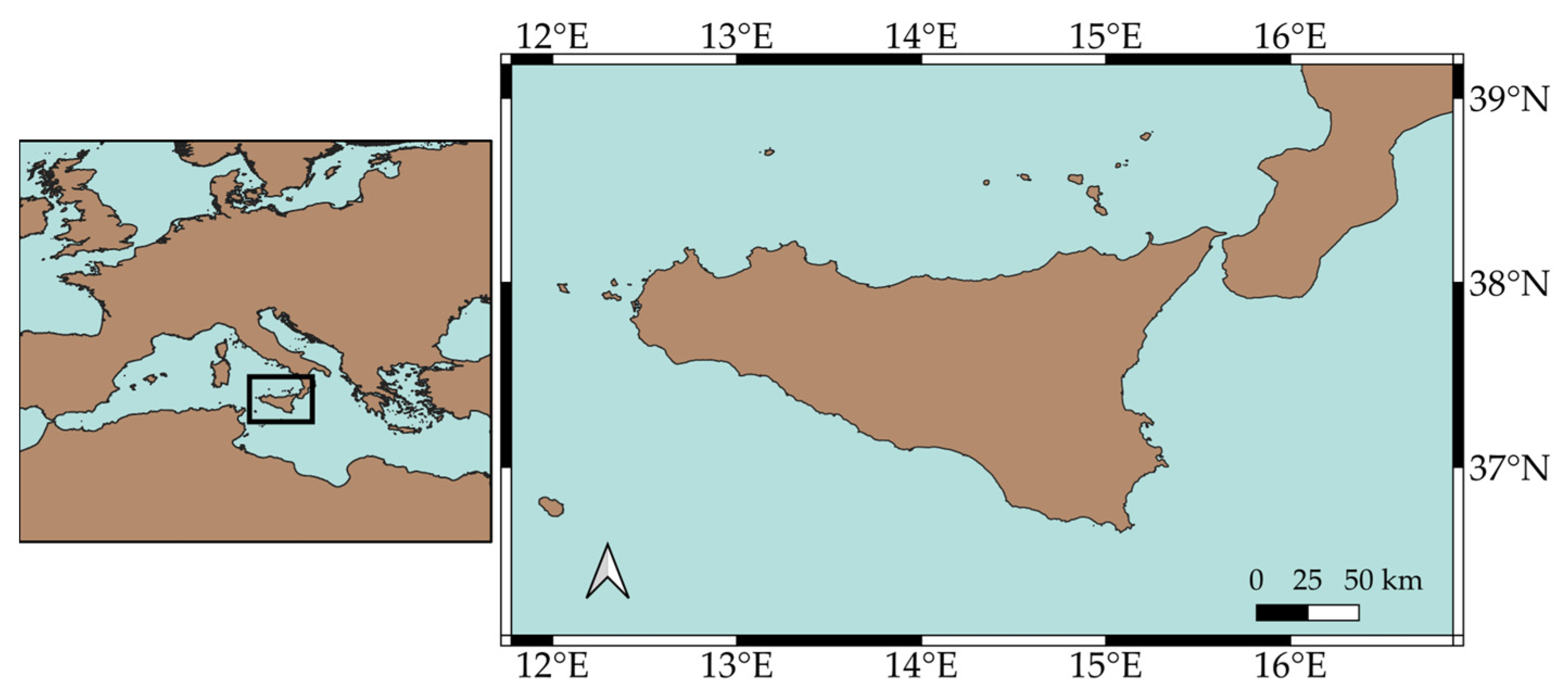

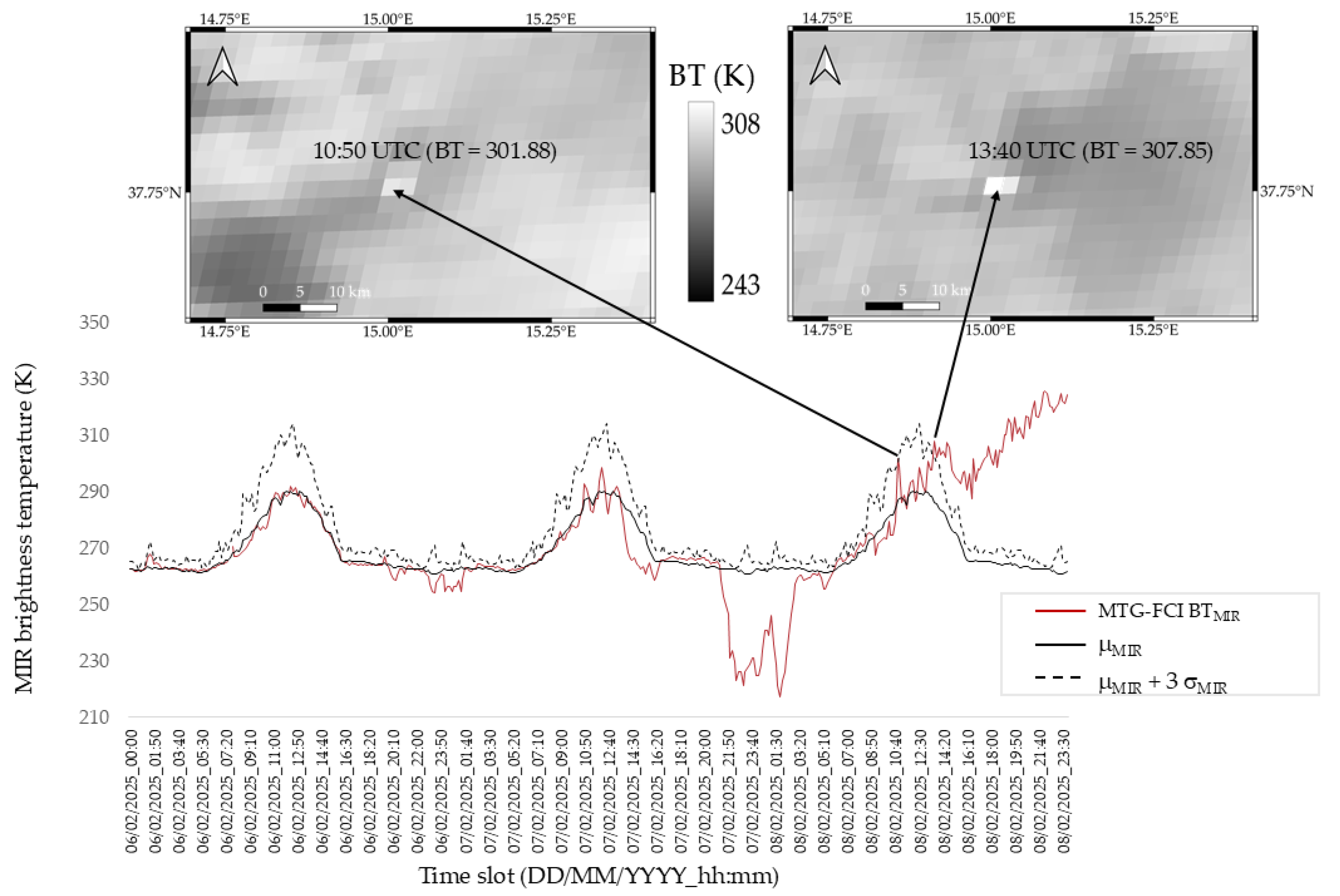
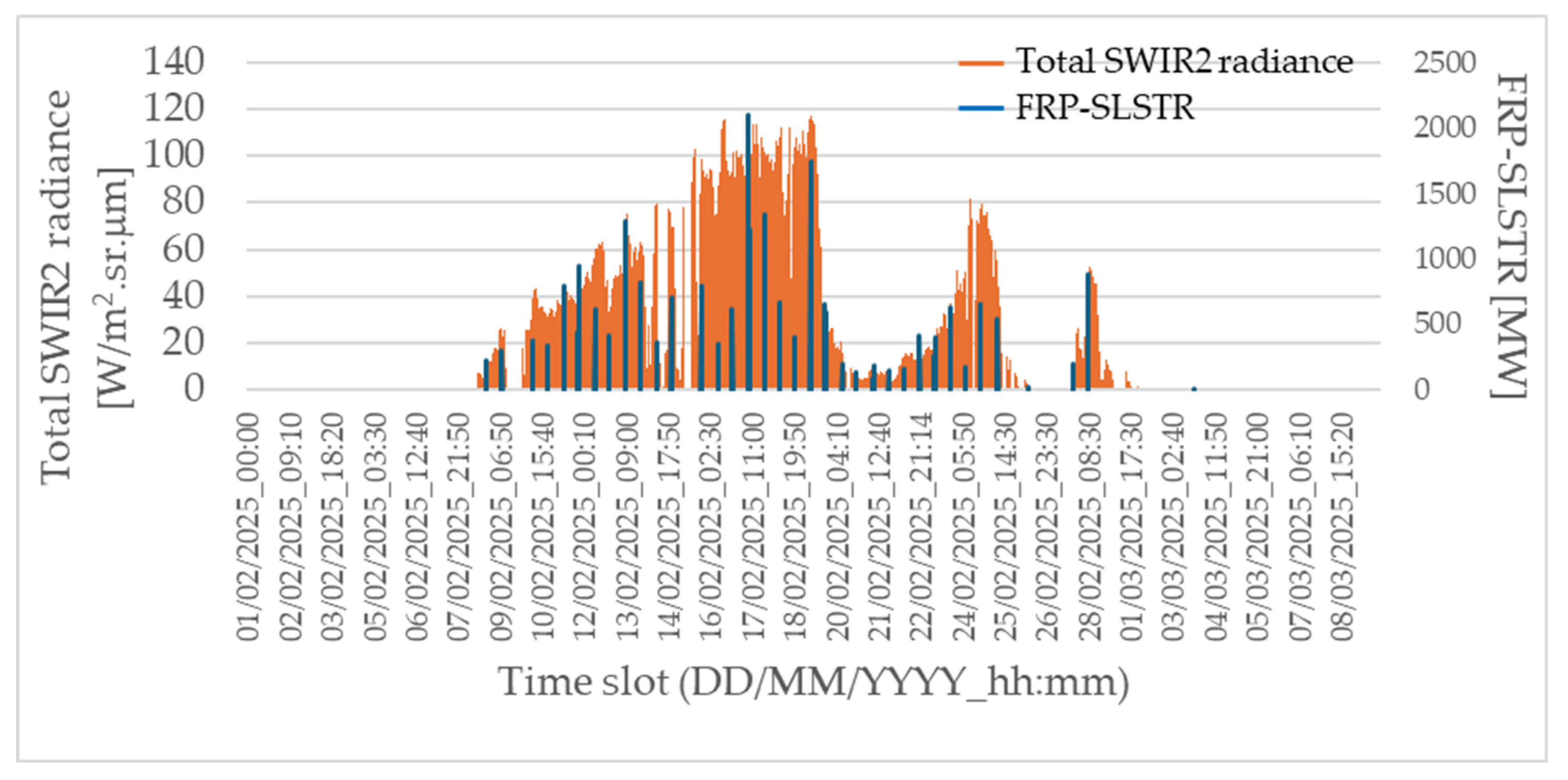
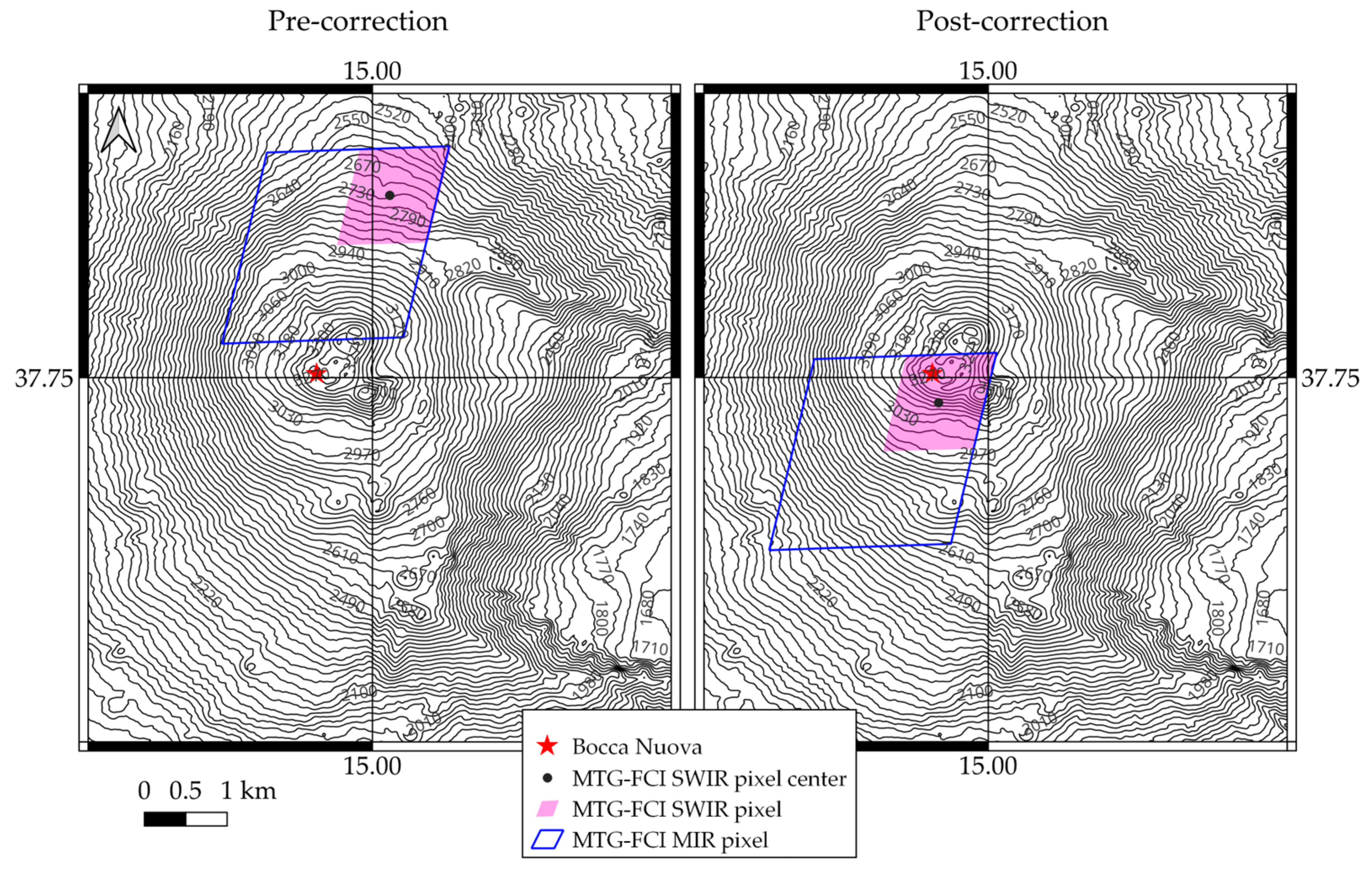
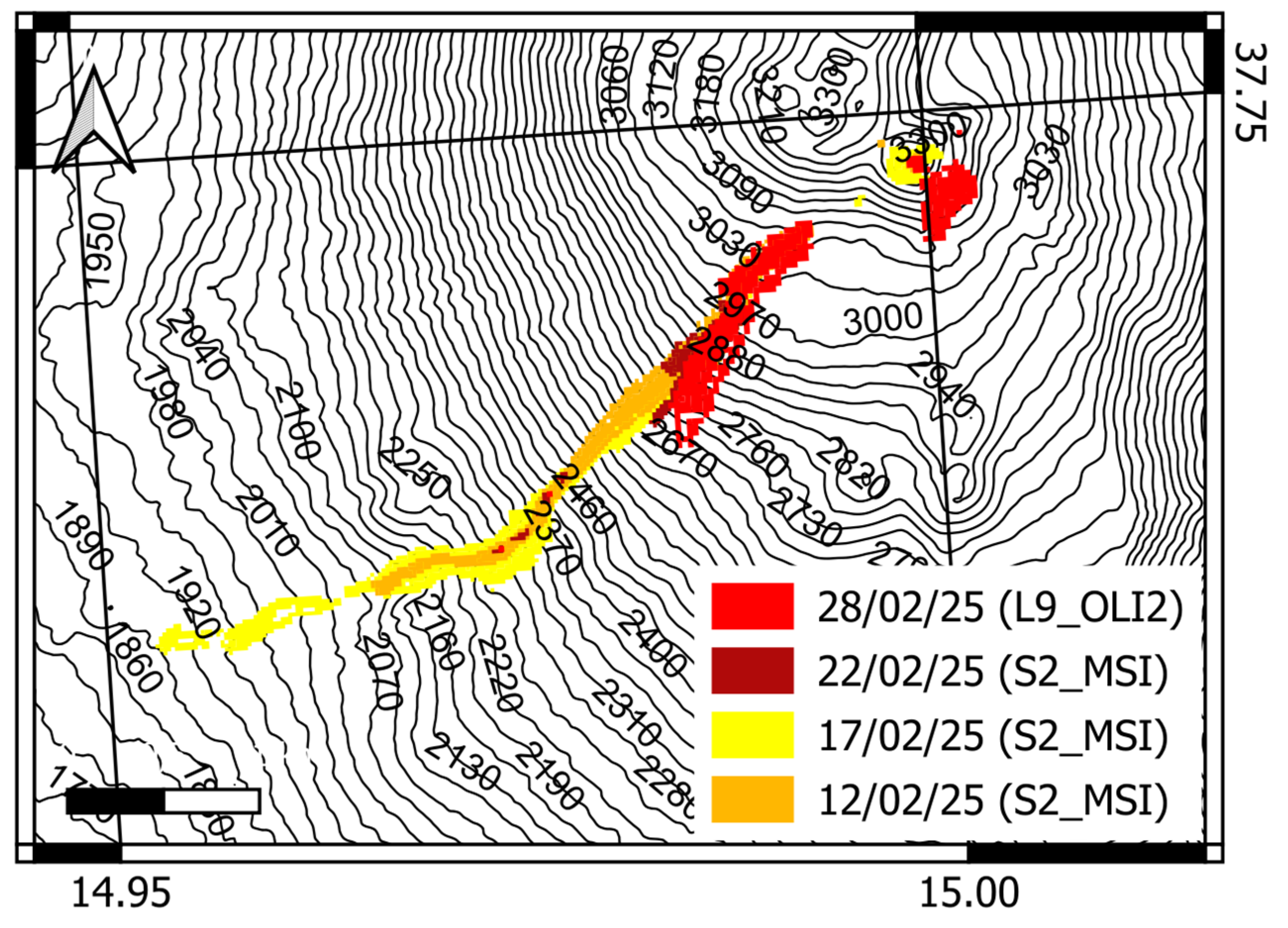
| Volcano | Eruptions | Thermal Features | Geostationary Satellite Platform | Spatial Resolution | Temporal Resolution | References |
|---|---|---|---|---|---|---|
| Kilauea (Hawaii) | 1997/1998 | lava flows | GOES-9 | 4 km | 15 min | [11,12,13,14] |
| Cerro Azul (Galapagos Islands) | 1998 | intra-caldera activity/lava flows | GOES-8 | [15] | ||
| Cerro Azul, Lascar (Chile), Popocatepetl (Mexico), Colima (Mexico), Pacaya (Guatemala), Soufriere Hills (Montserrat) | 1998 | lava flows, dome extrusion, dome cooling | GOES 8/9 | [14] | ||
| Popocatépetl | 1998/2000 | dome extrusion | GOES 8/10 | [16] | ||
| Santiaguito (Guatemala) | 1999 | lava flows | GOES 9 | [17] | ||
| Villarica (Chile) | 1999 | lava lake | GOES 8 | [18] | ||
| Etna (Italy) | 2005–2006, 2008, 2011–2012, 2017, 2021 | lava flows, lava fountains, Strombolian activity | MSG-SEVIRI | 3 km | 15 min | [19,20,21,22,23,24,25,26,27,28] |
| Jebel al-Tair (Yemen) | 2007 | lava flows | MSG-SEVIRI | [31] | ||
| Stromboli (Italy) | 2019, 2023 | lava flows | MSG-SEVIRI | [28,29,30] | ||
| Manda Hararo (Ethiopia), Jebel al-Tair (Yemen), Karthala (Comoros), Nyiragongo and Nyamuragira (Congo), Piton de la Fournaise (Reunion Island, France), Ol Doinyo Lengai (Tanzania), Soufriere Hills | 2006–2009 | lava flows, lava lakes, lava domes | MSG-SEVIRI | [32] | ||
| Cumbre Vieja | 2021 | lava flows | MSG-SEVIRI | [27] | ||
| Nabro (Eritrea, Africa) | 2011 | lava flows | MSG-SEVIRI | [33] | ||
| Merapi (Indonesia) | 2006 | lava flows | MTSAT-1R | 4 km | 30 min | [19] |
| Shinmoedake (Japan) | 2011 | lava fountains, lava dome | MTSAT-2 | 4 km | 30 min | [34] |
| Mt. Raung (Indonesia) | 2015 | lava flows/gas emissions | Himawari-8 AHI | 2 km | 10 min | [35,36] |
| Nishinoshima (Japan) | 2017/2019/2020 | lava flows/lava fountains | Himawari-8 AHI | [37,38,39] | ||
| Ambrym (Vanuatu), Krakatau (Indonesia), | 2018 | lava lakes/lava flows | Himawari-8 AHI | [40,41] | ||
| La Soufrière (St. Vincent) | 2021 | lava dome | GOES-16 ABI | 2 km | 10 min | [42] |
| Kilauea, Mauna Loa (Hawaii) | 2020, 2022 | lava flows | GOES-17 ABI | [41,43] |
| Channel Name | Central Wavelength (μm) | Spectral Width (μm) | Spatial Sampling Distance (km) at Normal or High Configuration Mode |
|---|---|---|---|
| VIS 0.4 | 0.444 | 0.060 | 1.0 NR |
| VIS 0.5 | 0.510 | 0.040 | 1.0 NR |
| VIS 0.6 | 0.640 | 0.050 | 1.0 NR 0.5 HR |
| VIS 0.8 | 0.865 | 0.050 | 1.0 NR |
| VIS 0.9 | 0.914 | 0.020 | 1.0 NR |
| NIR 1.3 | 1.380 | 0.030 | 1.0 NR |
| NIR 1.6 | 1.610 | 0.050 | 1.0 NR |
| NIR 2.2 | 2.250 | 0.050 | 1.0 NR 0.5 HR |
| IR 3.8 | 3.800 | 0.400 | 2.0 NR 1.0 HR |
| WV 6.3 | 6.300 | 1.000 | 2.0 NR |
| WV 7.3 | 7.350 | 0.500 | 2.0 NR |
| IR 8.7 | 8.700 | 0.400 | 2.0 NR |
| IR 9.7 | 9.660 | 0.300 | 2.0 NR |
| IR 10.5 | 10.500 | 0.700 | 2.0 NR 1.0 HR |
| IR 12.3 | 12.300 | 0.500 | 2.0 NR |
| IR 13.3 | 13.300 | 0.600 | 2.0 NR |
Disclaimer/Publisher’s Note: The statements, opinions and data contained in all publications are solely those of the individual author(s) and contributor(s) and not of MDPI and/or the editor(s). MDPI and/or the editor(s) disclaim responsibility for any injury to people or property resulting from any ideas, methods, instructions or products referred to in the content. |
© 2025 by the authors. Licensee MDPI, Basel, Switzerland. This article is an open access article distributed under the terms and conditions of the Creative Commons Attribution (CC BY) license (https://creativecommons.org/licenses/by/4.0/).
Share and Cite
Filizzola, C.; Mazzeo, G.; Marchese, F.; Pietrapertosa, C.; Pergola, N. The Contribution of Meteosat Third Generation–Flexible Combined Imager (MTG-FCI) Observations to the Monitoring of Thermal Volcanic Activity: The Mount Etna (Italy) February–March 2025 Eruption. Remote Sens. 2025, 17, 2102. https://doi.org/10.3390/rs17122102
Filizzola C, Mazzeo G, Marchese F, Pietrapertosa C, Pergola N. The Contribution of Meteosat Third Generation–Flexible Combined Imager (MTG-FCI) Observations to the Monitoring of Thermal Volcanic Activity: The Mount Etna (Italy) February–March 2025 Eruption. Remote Sensing. 2025; 17(12):2102. https://doi.org/10.3390/rs17122102
Chicago/Turabian StyleFilizzola, Carolina, Giuseppe Mazzeo, Francesco Marchese, Carla Pietrapertosa, and Nicola Pergola. 2025. "The Contribution of Meteosat Third Generation–Flexible Combined Imager (MTG-FCI) Observations to the Monitoring of Thermal Volcanic Activity: The Mount Etna (Italy) February–March 2025 Eruption" Remote Sensing 17, no. 12: 2102. https://doi.org/10.3390/rs17122102
APA StyleFilizzola, C., Mazzeo, G., Marchese, F., Pietrapertosa, C., & Pergola, N. (2025). The Contribution of Meteosat Third Generation–Flexible Combined Imager (MTG-FCI) Observations to the Monitoring of Thermal Volcanic Activity: The Mount Etna (Italy) February–March 2025 Eruption. Remote Sensing, 17(12), 2102. https://doi.org/10.3390/rs17122102










